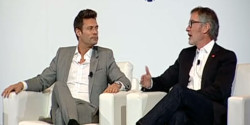iHeartMedia (née Clear Channel) CEO Bob Pittman and radio/TV host Ryan Seacrest were both present at the Consumer Electronics Show this week, and they were stumping for radio. Pittman began an on-stage interview on Wednesday declaring that “radio is probably the most relevant product that rides on all this technology… radio is your best friend.”
He noted that in 1970 radio reached 92% of Americans, and in 2014 it still reaches 92% of Americans. The phone and computer now amount to additional radios, Pittman said.
Seacrest joined him, saying that “we can’t think of radio as just radio,” but as “everywhere,” since hosts like him spend so many hours a week with a listener. “We want to be their companion.”
Pittman talked up the live aspect of radio, which he said further differentiates it from television, which he said young people principally understand as always available. He also said that iTunes and streaming music is for when you want to escape the world and radio is for when you want to connect with the world.
On the face of things, it’s hard to find fault with Pittman’s and Seacrest’s assertions about radio, or at least live host-driven radio. The problem is that only a portion of commercial radio programming actually exemplifies these qualities.
Sure, morning drive programs are likely to feature dynamic hosts and live news, traffic and weather updates that connect the listener to the world. Even if the show itself is syndicated from a bigger market, I’ll admit that there’s a good chance there will at least be some local weather and maybe some news headlines inserted a couple times an hour.
But outside flagship stations in the biggest markets, most FM stations revert to automation for the rest of the broadcast day. Depending on the market and the company, the voice listeners hear and the programming decisions may not even be local. And good luck hearing any news and weather outside drivetime. There’s no more companionship or “being in touch with the world” in that than there is with a rerun of M*A*S*H on afternoon TV.
AM talk stations have a different kind of automation, with the vast majority of them piping in the same syndicated programs, again with very little local content. This may constitute companionship for the dwindling and rapidly aging AM listenership, but it really doesn’t for the millions upon millions of radio listeners who aren’t white men over the age of 35.
The utter bland sameness of most of the commercial radio broadcast day is probably one big reason why listenership for the iHeartRadio online platform has stalled out. As Edison Research reports, iHeartRadio added listeners at a fast pace beginning in 2011, peaking with 245,463 average listeners in May 2013. Since then, the number has dipped to around 242,000 and stayed there. By comparison, in the same period since May 2013 Pandora grew 32%.
To explain it, Edison observes that,
“most all of the sites that are geared (or mostly geared) to the streams of AM/FM Radio stations are flat or down since May of 2013. Cumulus is down 22% from that time in the September Triton numbers. CBS is down 14%. ESPN and Greater Media show modest gains. In general – it is more than fair to say the business of streaming the content of American radio stations is stagnant at best.”
That makes sense to me. Let’s just take for example the classic rock format. An app like iHeartRadio serves up dozens of stations with nearly identical playlists. You might use iHeart to listen somewhere you can’t use a radio, or if you’ve got a particular fondness for a distant station. And even I admit it can be fun tuning in stations from all over the country. But the novelty wears off quickly when you realize that the vast majority don’t actually vary much from your own local stations.
The sad thing is that there’s nothing inherent in this state of affairs. There is some good commercial radio out there. The reason there isn’t more is that the nation’s largest broadcasters built their empires by leveraging themselves with mountains of debt to hoover up stations, squeezing out profits by jettisoning DJs, producers, programmers and local management. It worked for a little while, but that era ended a decade ago.
iHeartMedia, Cumulus, Citadel, CBS – they can bring back the vibrancy of the kind of personality-driven live radio that Pittman lauds. They either just don’t want to spend the money, or they really don’t have the money to spend. That’s not because radio is dying, but because all the big owners spent the last 19 years starving the cash cow, while all but chasing away every new listener under the age of 30.
It’s reasonable to be optimistic about radio, especially the dynamic and live kind of radio Pittman praises. iHeartMedia-style radio, not so much.



